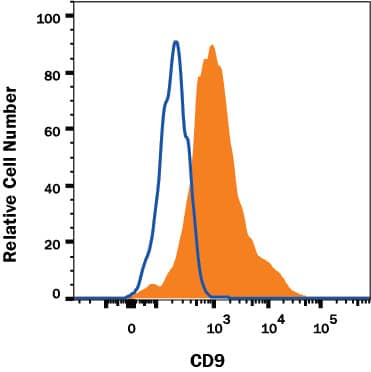Mouse CD9 Antibody
R&D Systems, part of Bio-Techne | Catalog # MAB5218


Key Product Details
Species Reactivity
Validated:
Cited:
Applications
Validated:
Cited:
Label
Antibody Source
Product Specifications
Immunogen
Pro2-Val226
Accession # P40240
Specificity
Clonality
Host
Isotype
Scientific Data Images for Mouse CD9 Antibody
Detection of CD9 in D3 Mouse Cell Line by Flow Cytometry.
D3 mouse embryonic stem cell line was stained with Rat Anti-Mouse CD9 Monoclonal Antibody (Catalog # MAB5218, filled histogram) or isotype control antibody (Catalog # MAB006, open histogram) followed by anti-Rat IgG APC-conjugated antibody (Catalog # F0113). View our protocol for Staining Membrane-associated Proteins.CD9 in Mouse Kidney.
CD9 was detected in perfusion fixed frozen sections of mouse kidney using Rat Anti-Mouse CD9 Monoclonal Antibody (Catalog # MAB5218) at 25 µg/mL overnight at 4 °C. Tissue was stained using the Anti-Mouse HRP-DAB Cell & Tissue Staining Kit (brown; Catalog # CTS002) and counterstained with hematoxylin (blue). Specific staining was localized to cytoplasm in convoluted tubules. View our protocol for Chromogenic IHC Staining of Paraffin-embedded Tissue Sections.Applications for Mouse CD9 Antibody
CyTOF-ready
Flow Cytometry
Sample: Mouse D3 cell line
Immunohistochemistry
Sample: Perfusion fixed frozen sections of mouse kidney
Formulation, Preparation, and Storage
Purification
Reconstitution
Formulation
Shipping
Stability & Storage
- 12 months from date of receipt, -20 to -70 °C as supplied.
- 1 month, 2 to 8 °C under sterile conditions after reconstitution.
- 6 months, -20 to -70 °C under sterile conditions after reconstitution.
Background: CD9
CD9, also known as motility-related protein-1 (MRP-1), is a 24 kDa glycoprotein of the tetraspanin family that is expressed by a variety of hematopoietic and epithelial cells. It forms homotypic and heterotypic associations with other tetraspanin proteins, some integrins and MHC class II proteins. CD9 has been shown to modulate cellular adhesion, migration and proliferation. The extracellular portions of mouse CD9 share 81% and 88% amino acid identity with corresponding regions of human and rat CD9, respectively.
Alternate Names
Gene Symbol
UniProt
Additional CD9 Products
Product Documents for Mouse CD9 Antibody
Product Specific Notices for Mouse CD9 Antibody
For research use only
